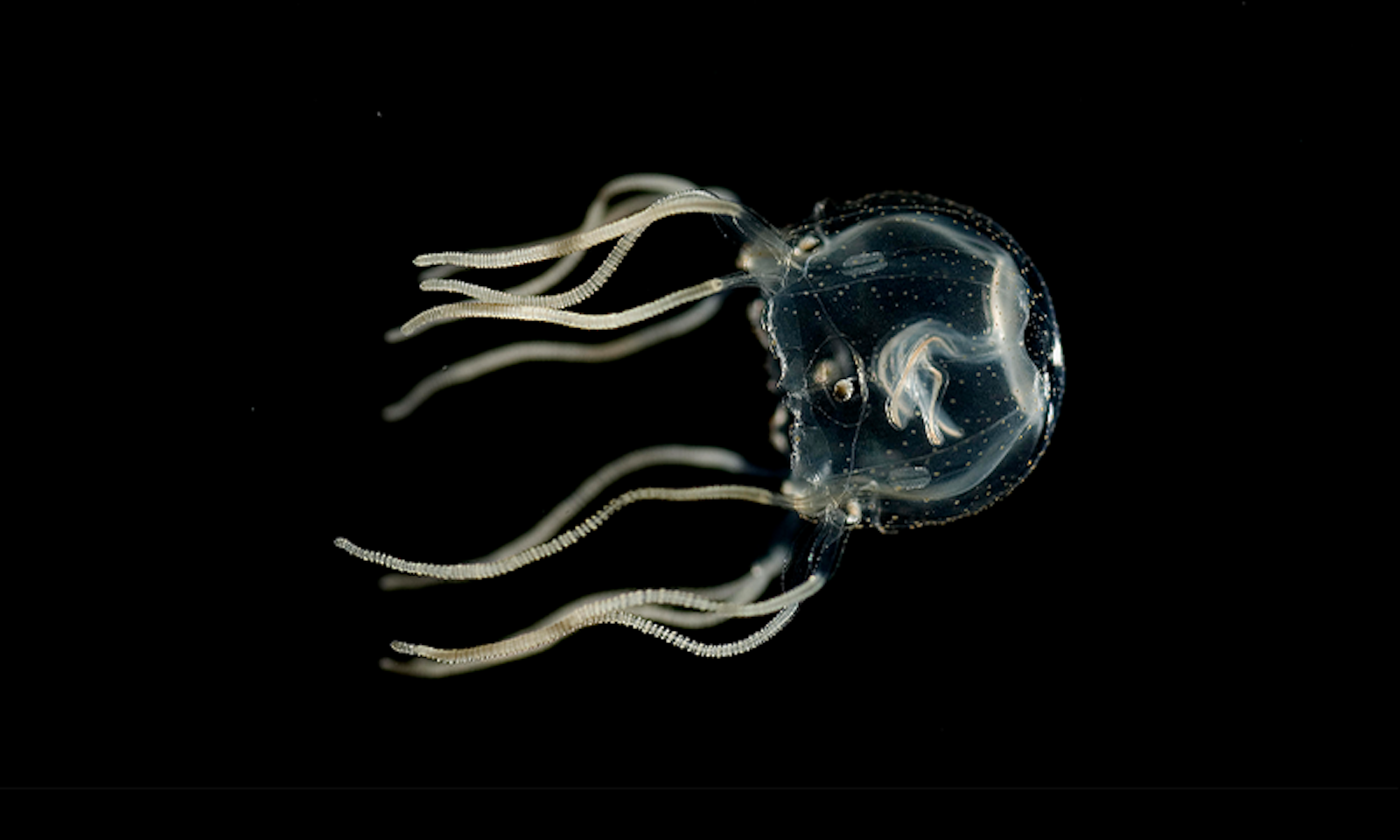The tiny box jellyfish lives in warm costal waters all over the world, including the murky waters of the mangrove forests of the Caribbean. Barely the size of a fingernail, they swiftly navigate a dark underwater maze of tangled roots scouting for their prey—water fleas.
The bell-shaped bodies of these jellyfish (Tripedalia cystophora) are so small and simple that they lack a brain. Yet, despite that seeming obstacle, they are exceedingly fast learners, scientists report in a recent study in the journal Current Biology. They can quickly form and retain memories about sensory information they receive from the environment and can adapt their behavior in response. The findings suggest that a “brain” is not as essential to learning as we thought.
In many ways, T. cystophora are unique creatures. They have far more sophisticated vision systems than other types of jellyfish, possessing four specialized visual sensory centers called rhopalia. Each rhopalia holds six eyes—for a total of 24—and contains around 1,000 neurons, so the jelly has a total of 4,000. (By comparison, a fruit fly has 200,000 neurons.) The rhopalia generate electric signals that govern how fast the jellyfish pulsates through the water. Its pulsing motion quickens when the animal chases a flea or swerves to avoid crashing into tree roots.
While many other types of jellyfish can only detect light—sensing the direction it is coming from and following it—T. cystophora can also discern the contrast between dark and light, which means it can form images. “Two of their eye-structures are camera-type eyes which are basically built like yours and mine,” says senior author Anders Lydik Garm, associate professor of marine biology of the University of Copenhagen, Denmark.
Even without a brain, jellyfish can learn from experience.
Garm and study co-author Jan Bielecki, who studies neurobiology at the Kiel University, Germany wanted to know whether the jellies’ behavior—swerving between dark and light—was hardwired, or whether the jellies could learn new behavior. In their natural habitat, the jellies use their visual sense of contrast to distinguish the dark tree roots from the brighter water to avoid bumping into the tangles of protruding roots. “They use the contrast, because contrast is the difference between how dark the root is and how bright the water is,” explains Garm. “That contrast is how they evaluate distance.” But could they learn to avoid obstacles that look different from the ones in their natural environment?
Garm and Bielecki set up an experiment. They outfitted a fish tank with a bunch of gray and white plastic strips, which were meant to mimic the tree roots and light streaming through. The trick was that to the jellyfish, the light gray color looked like a root that was simply far away. “In reality it wasn’t far away. It just seemed far away because we painted it gray,” Garm explains. Initially, the jellies perceived the gray “roots” as being remote—and bumped into them. But after a few bumps, they would learn to avoid the gray strips. “They get the mechanical sensory input telling them, OK, this root was much closer than it originally appeared,” says Garm—and they start changing their behavior.
Less than 10 minutes into the experiment, the jellies quadrupled the number of successful pivots to avoid collision, scientists found. “They learned that in this condition, low contrast still means that the ‘root’ is close by and then within three to five errors of bumping into the root they learn to turn earlier and not bump into it,” Garm says. “We were surprised at how quickly they learned.” This form of learning is called associative learning: The jellies learn to associate sensory stimuli—such as images of the gray strips—with bumps, to remember this association and then adapt future behavior.
The findings suggest that even without a brain, jellyfish can learn from experience through visual and mechanical stimuli, researchers say. But if the jellyfish doesn’t have a brain, where are these memories stored? Garm says that this learning may happen within the cells of the distributed nervous system, particularly the neurons in the rhopalia. These neurons form a memory of sensory stimulation, which then becomes associated with a particular behavior: The image of the root, plus the bump, leads to avoidance.
“Our study suggests—due to the unique evolutionary position of jellyfish—that learning is an integral function of the neuron, or at least a small neuronal circuit,” says Bielecki. If a neuron or neuronal circuit is all that is required for memory and learning, he says, then perhaps we need to rethink how we define the term “brain.” It seems you can be a bit “brainy” without one—at least, if you’re a box jellyfish. ![]()
Lead photo by Jan Bielecki




























